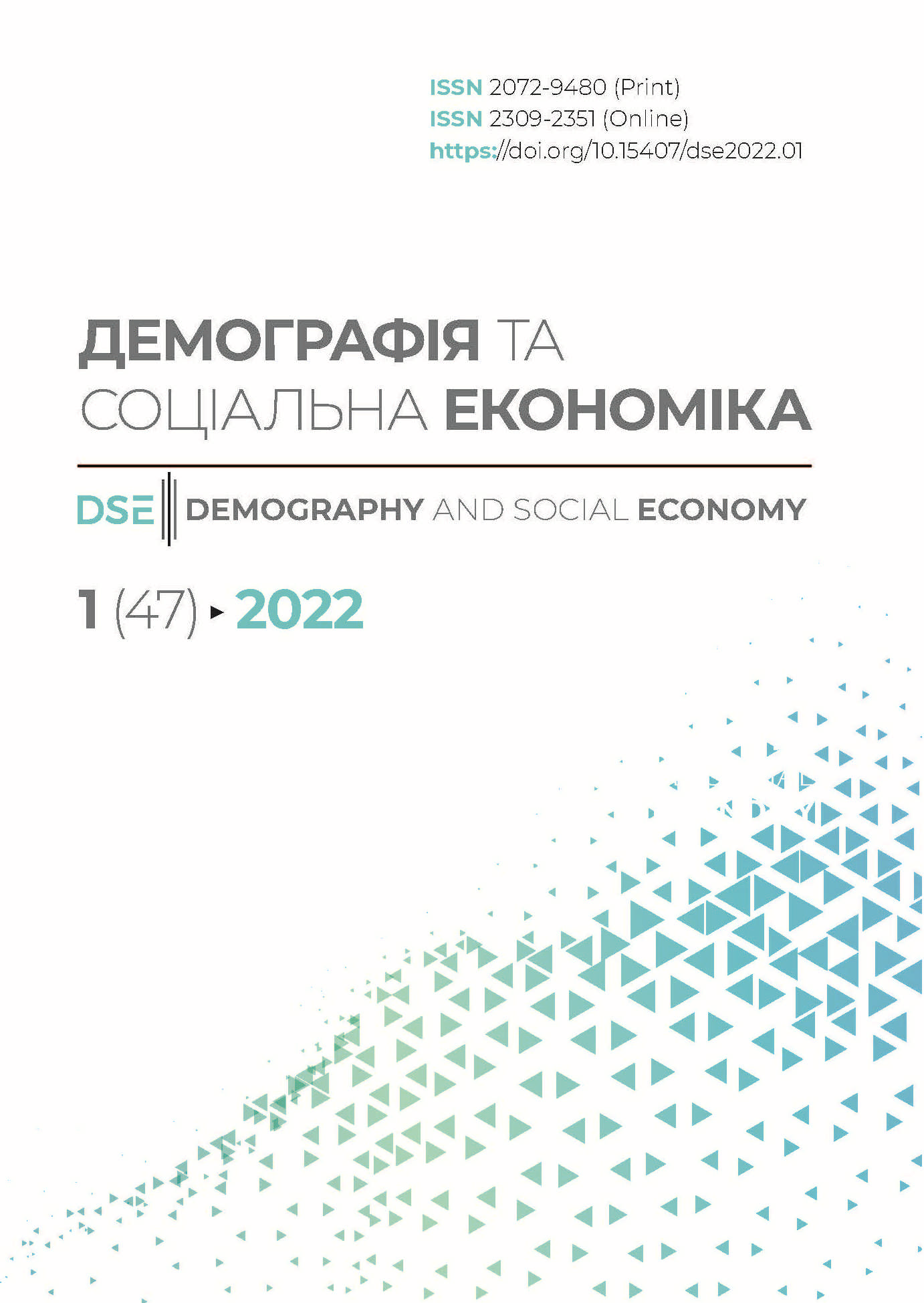DEMOGRAPHIC DIMENSION OF POST-SOVIET REGIONALIZATION IN UKRAINE THROUGH THE LENS OF REGIONOPOLIZATION CONCEPT
DOI:
https://doi.org/10.15407/dse2022.01.021Keywords:
regionalization, regionopolization, regionopolis, shrinking cities, polycentric development, UkraineAbstract
The article presents the results of testing the “regionopolization” concept in the context of Ukrainian regions’ demographic development. The concept of regionopolization has a good applied potential for the needs of regional policy, especially in the framework of the development of the General Plan of the territory of Ukraine. The aim of the paper is to identify the spatiotemporal features of the regionopolization processes in Ukrainian regions and to determine the demographic patterns of these processes during 1989-2021. The novelty of the article lies in the deep study of the demographic aspect of the regionopolization processes in different periods of Ukrainian regions’ development with a focus on the study of development trajectories of regionopolises. The empirical database of this study consists of official data from the 1989 and 2001 censuses, as well as estimates from the State Statistics Service of Ukraine. To achieve the aim of the paper, a number of methods are used: elements of descriptive statistics, the method of classification, the method of cartographic modelling etc. Empirical results have shown that the demographic patterns of regionopolization processes in Ukraine reflect the current socio-economic asymmetry of the country’s regional development. It is substantiated that both the vertical (mono- or polycentric regions) and the horizontal (mono- or polycentric regionopolises) spatial dimension are important in the delimitation of the system of regionopolises. It is established that during 1989-2021 more than half of Ukrainian regionopolises were shrinking, moreover, the majority were large and medium-sized regional centres. It is found that a regressive regionopolization, which is the dominant type of regionopolization in Ukraine, is a result of the overlapping numerous exogenous and endogenous socio-economic problems in the regions with the exhaustion of the demographic potential of the regions’ peripheral territories. In addition to regressive regionopolization, monocentric regions are another problem, as an excessive concentration of labour and capital in its regional centres (in which at least 40% of the region’s population is concentrated) leads to increased intra-regional disparities and polarization. Therefore, to counteract the shrinking regional centres and stimulate the development of regions’ periphery, it is necessary, firstly, to develop strategies and programs for polycentric development of monocentric regions, secondly, to support the development of small and medium-sized cities, and, finally, to promote interregional socio-economic cooperation.
REFERENCES
- Havryliuk, O. (2021). Differential and Non-Differential Urbanization in Ukraine during the Soviet and Post-Soviet Era. Visnyk of V. N. Karazin Kharkiv National University, Series «Geology. Geography. Ecology», 55, 141-158. https://doi.org/10.26565/2410-7360-2021-55-11 [in Ukrainian].
- Wolff, M., & Wiechmann, T. (2018). Urban growth and decline: Europe’s shrinking cities in a comparative perspective 1990-2010. European Urban and Regional Studies, 25 (2), 122-139. https://doi.org/10.1177/0969776417694680
- Haase, A., Bernt, M., Großmann, K., Mykhnenko, V., & Rink, D. (2016). Varieties of shrinkage in European cities. European Urban and Regional Studies, 23 (1), 86-102. https://doi.org/10.1177/0969776413481985
- Mykhnenko, V. & Turok, I. (2008). East European Cities - Patterns of Growth and Decline, 1960-2005. International Planning Studies, 13 (4), 311-342. https://doi.org/10.1080/13563470802518958
- Turok, I. & Mykhnenko, V. (2007). The trajectories of European cities, 1960-2005. Cities, 24(3), 165-182. https://doi.org/10.1016/j.cities.2007.01.007
- Hirt, S. & Beauregard, R. (2021). Must shrinking cities be distressed cities? A historical and conceptual critique. International Planning Studies, 26 (1), 1-13. https://doi.org/10.1080/13563475.2019.1661226
- Friedmann, J. (1966). Regional Development Policy: A Case Study of Venezuela. Cambridge, Massachusetts: MIT Press.
- Wallerstein, I. (1974). The Modern World-System I: Capitalist Agriculture and the Origins of the European World-Economy in the Sixteenth Century. New York: Academic Press.
- Alayev, E. B. (1983). Social-economic geography. Conceptual-terminologic dictionary. Moscow: Mysl'[in Russian].
- Ridevskyi, G. V. (2013). Center-peripheral processes in settlement of the population of modern Belarus. Regional Studies, 2 (40), 94-99. https://ekonomika.by/downloads/Ridevski_2013-4.pdf [in Russian].
- Ridevskyi, G. V. (2004). Regionopolization of the territorial structure of the economy and settlement of the Republic of Belarus. In: Northwestern Russia: problems of ecology and socio-economic development, 304-306. Pskov: Revival Center Publishing House with the assistance of OCNT Publishing House [in Russian].
- Ridevskyi, G. V. (2011). The processes of regionopolization, structural heterogeneity and social division of the Russian-Belarus border regions. Regional Studies, 4 (34), 127-133. http://ekonomika.by/downloads/Ridevski_2011-2.pdf [in Russian].
- Shults, S. L. (2012). Formation and development of the economic space of Ukrainian regions. (Extended abstract of doctor’s thesis). Dolishniy Institute of Regional Research of NAS of Ukraine. Lviv. https://mydisser.com/ru/catalog/view/11219.html [in Ukrainian].
- Mezentsev, K. V., & Havryliuk, O. K. (2015). Polarization of the settlement of Ukrainian population through the prism of the concept of regionopolization. Regional problems of Ukraine: geographical analysis and search for solutions. Kherson. http://eKhSUIR.kspu.edu/handle/123456789/5703 [in Ukrainian].
- Ridevskyi, G. V. (2012). Territorial structures of settlement, economy and management of natural resources of modern Belarus. Geography and Turism, 18, 207-215. http://nbuv.gov.ua/UJRN/gt_2012_18_38 [in Russian].
- Mezentsev, K., & Pidgrushnyi, G. (2014). Ukraine: stable outflow and changing nature. Discovering migration between Visegrad countries and Eastern partners, 191-211. Budapest: HAS RCAES Geographical Institute. http://www.eastmig.mtafki.hu/results.html
- Hall, P. (2009). Polycentricity. International Encyclopedia of Human Geography, 260-264). Elsevier. https://doi.org/10.1016/B978-008044910-4.00857-9
- Havryliuk, O., Gnatiuk, O., & Mezentsev, K. (2021). Suburbanization, but centralization? Migration patterns in the post-Soviet functional urban region - evidence from Kyiv. Folia Geographica, 63 (1), 64-84. http://www.foliageographica.sk/unipo/journals/2021-63-1/587
Downloads
Published
How to Cite
Issue
Section
License
Copyright (c) 2022 Олексій Гаврилюк

This work is licensed under a Creative Commons Attribution-NonCommercial-NoDerivatives 4.0 International License.


